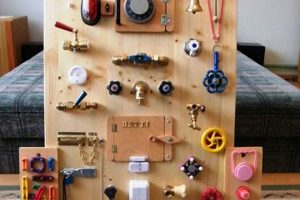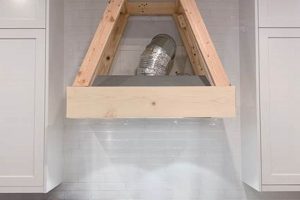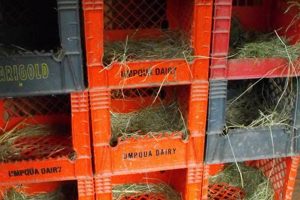A homemade solution designed to capture and eliminate stinging insects of the Vespula genus is a common pest control strategy. These devices often utilize a sweet or protein-based bait within a container to lure the insects, preventing their escape and ultimately leading to their demise. For instance, a plastic bottle modified to contain sugar water can function as a rudimentary, yet effective, capture system.
The creation of such a device offers an economical alternative to commercially available products. It allows individuals to address localized infestations promptly and reduce the need for professional pest control services. Furthermore, these constructed systems can be tailored to specific environments and bait preferences, potentially increasing their effectiveness. Historically, the practice of creating such solutions reflects a long-standing human effort to manage pests using readily available resources.
The subsequent sections will provide detailed instructions on constructing different models, explore optimal bait choices, and address safety considerations crucial for successful implementation. Understanding the behavior of targeted species and proper placement of the device are also essential elements to be discussed.
Essential Guidance for Effective Insect Capture Systems
The following guidelines are intended to maximize the effectiveness and safety of self-constructed insect capture systems designed for yellow jackets. Adherence to these recommendations will improve success rates and minimize potential hazards.
Tip 1: Location Selection: Place the device strategically. Optimal locations include areas with high yellow jacket activity, such as near garbage receptacles, outdoor eating areas, or known nest locations. Avoid placing them directly in areas of frequent human traffic to minimize accidental stings.
Tip 2: Bait Selection and Preparation: Experiment with different baits. Yellow jackets are attracted to both sweet and protein-based substances. Early in the season, protein-based baits (e.g., small pieces of meat or fish) may be more effective. Later in the season, sweet baits (e.g., sugar water, fruit juice) may prove more appealing. A small amount of dish soap added to the bait can break surface tension, causing the insects to drown more readily.
Tip 3: Device Construction and Stability: Ensure the device is structurally sound and stable. Use durable materials that can withstand outdoor conditions. The entry points should be designed to allow easy access for yellow jackets but impede their exit. A wide base or secure mounting can prevent accidental tipping.
Tip 4: Maintenance and Monitoring: Regularly monitor and maintain the device. Remove dead insects to prevent overcrowding and maintain the attractiveness of the bait. Replenish the bait as needed, typically every few days or as it becomes depleted or contaminated.
Tip 5: Safety Precautions: Exercise caution when handling the device, especially if it contains live insects. Wear protective clothing, such as long sleeves and gloves, when approaching the device. Avoid sudden movements that could provoke the insects.
Tip 6: Nest Identification and Professional Assistance: If the yellow jacket problem persists despite the deployment of the device, consider identifying and treating the nest directly. However, if the nest is large or located in a difficult-to-access area, it is advisable to seek professional pest control services.
Tip 7: Seasonal Considerations: Adjust the bait and placement strategies based on the season. Yellow jacket behavior and food preferences can change throughout the year. Understanding these seasonal variations will improve the device’s effectiveness.
Implementing these guidelines can significantly enhance the performance of self-made insect capture systems, providing effective control over local yellow jacket populations and reducing the risk of stings.
The following section will explore alternative strategies and advanced techniques for managing yellow jacket infestations, including preventative measures and environmental modifications.
1. Construction Materials
The selection of construction materials directly impacts the efficacy and longevity of a self-constructed yellow jacket trapping device. The chosen materials influence the trap’s resistance to environmental factors such as sunlight, rain, and temperature fluctuations, all of which can degrade the structure over time and reduce its effectiveness. For example, using a thin, brittle plastic bottle may result in cracking or breakage, rendering the trap useless and potentially scattering the captured insects. Conversely, employing a more durable, UV-resistant plastic container ensures a longer lifespan and maintains structural integrity, even under harsh conditions. Furthermore, the material’s transparency affects the ease with which yellow jackets can locate and enter the trap. Clear materials allow for better visibility of the bait, increasing the likelihood of attracting the insects.
Beyond durability and transparency, the material’s chemical inertness is also a critical factor. Certain plastics can react with the bait, altering its composition and potentially deterring yellow jackets. For instance, using a container made from a reactive plastic could leach chemicals into the bait solution, creating an unpleasant or even repellent odor. This can negate the trap’s intended purpose and render it ineffective. Conversely, using a food-grade, chemically inert plastic ensures that the bait remains uncontaminated and retains its attractive properties. The choice of cutting tools and adhesives used in construction is also important. Sharp cutting implements ensure clean edges, minimizing the risk of injury during handling. Weather-resistant adhesives provide a secure bond between components, preventing leaks or structural failures.
In summary, the selection of appropriate construction materials is paramount to the successful implementation of a homemade yellow jacket trapping device. Durable, UV-resistant, and chemically inert materials contribute to the trap’s longevity, effectiveness, and safety. While readily available materials might be tempting for cost-saving purposes, the long-term benefits of using higher-quality construction components outweigh the initial expense. This detailed approach minimizes the need for frequent replacements and enhances the overall efficiency of the pest control strategy.
2. Bait Attractiveness
The efficacy of a constructed trapping device is directly proportional to the attractiveness of the bait employed. Bait attractiveness acts as the primary driver for luring yellow jackets into the trap, and without a compelling attractant, the device remains largely ineffective. The selection and preparation of the bait are therefore critical components in the successful operation. Th
e specific compounds and concentrations within the bait solution determine its appeal to yellow jackets. Considerations must be given to their seasonal dietary preferences, which shift from protein sources during colony establishment to carbohydrate sources as the season progresses. For example, a protein-based bait, such as decaying meat scraps or fish, may be more effective in the early spring when queens are actively seeking protein to feed their developing brood. A sugar-based bait, such as fruit juice or sugar water, may be more effective later in the summer when the colony requires carbohydrates for energy.
In addition to the primary attractant, the presence of certain additives can enhance the bait’s appeal. Small quantities of fruit, such as overripe banana or apple, can release volatile organic compounds that attract yellow jackets from a greater distance. Similarly, the inclusion of a small amount of vinegar can mimic the fermentation process and further enhance the bait’s attractiveness. The concentration of the attractant is also a key factor. Too high a concentration may be repellent, while too low a concentration may not be sufficiently appealing. Experimentation with varying concentrations is often necessary to determine the optimal level for a given location and season. The presentation of the bait is also important. It should be readily accessible to the yellow jackets, but designed to prevent them from easily escaping once inside the trap.
The understanding of bait attractiveness as a pivotal element is paramount. The absence of proper bait selection leads to failed efforts in trapping. This understanding supports continuous refinement of bait recipes and optimizes trapping efficiency. Addressing the challenges of finding the “perfect” bait involves understanding regional variances, seasonal shifts, and species-specific preferences to enhance trapping success and reduce yellow jacket populations in targeted areas. The appropriate balance of attractants and additives, alongside the careful adjustment of concentrations, dictates the functionality of trapping solutions.
3. Trap Placement
The effectiveness of any self-constructed yellow jacket trapping device hinges significantly on strategic positioning. Incorrect placement diminishes the device’s utility, regardless of the quality of its construction or bait. Proximity to potential yellow jacket nesting sites, foraging areas, and flight paths dictates the likelihood of intercepting the insects. For example, placing a trap far from any identifiable yellow jacket activity yields minimal results, whereas positioning it near a known nest entrance, while potentially hazardous, maximizes the capture rate. Similarly, locations near common food sources, such as garbage cans or compost piles, are likely to attract higher numbers of yellow jackets. Understanding foraging behavior enables informed placement decisions.
Environmental factors also play a crucial role. Shaded areas may be preferable in hot climates to prevent the bait from overheating and becoming less attractive. Wind direction should be considered to ensure that the scent of the bait is carried towards potential yellow jacket habitats. The height of the placement also influences capture rates; yellow jackets typically forage at lower altitudes, so positioning the trap closer to the ground is often more effective. Furthermore, the surrounding vegetation can either enhance or hinder the trap’s performance. Dense foliage may obscure the trap from view, whereas open areas allow for greater visibility and scent dispersal. Real-world applications reveal that iterative adjustments to placement are often necessary to optimize capture rates. Constant monitoring and relocation based on observed yellow jacket activity are essential components of successful trapping strategies.
In conclusion, trap placement represents a critical determinant of effectiveness of any yellow jacket trapping device. Strategic consideration of nesting sites, foraging areas, environmental factors, and iterative adjustments based on observation are paramount. Neglecting this aspect can render even the most sophisticated trapping design largely ineffective, highlighting the practical significance of understanding and implementing informed placement strategies. Successful implementation necessitates a comprehensive understanding of yellow jacket behavior and environmental dynamics.
4. Safety Measures
The safe utilization of self-constructed yellow jacket capture systems necessitates strict adherence to precautionary procedures. These measures are paramount in mitigating the inherent risks associated with handling potentially aggressive insects and constructing potentially hazardous devices.
- Protective Attire
The wearing of appropriate protective attire constitutes a primary safety measure. Long sleeves, gloves, and eye protection are essential to prevent stings and allergic reactions. The material should be thick enough to resist penetration by yellow jacket stingers. Full-body suits may be considered in areas with high yellow jacket populations or for individuals with known allergies.
- Strategic Placement
Careful consideration of device placement is critical to minimize human and animal contact. The device should be positioned away from high-traffic areas, children’s play areas, and pet access points. Elevated placement may be advisable to reduce accidental contact, but must be balanced with the need for accessibility for maintenance and bait replenishment.
- Safe Handling and Disposal
Handling and disposal of the device, particularly when it contains live or dead insects, requires extreme caution. Sudden movements should be avoided to prevent provoking the insects. The device should be emptied in a contained manner, preferably into a sealed bag for disposal. In cases of live insects, freezing the device before disposal may be a humane option.
- Allergy Awareness and Emergency Preparedness
Individuals with known allergies to insect stings must exercise heightened caution and ensure they carry appropriate medication, such as an epinephrine auto-injector. Emergency contact information should be readily available. Family members or close contacts should be informed of the individual’s allergy and trained in the administration of emergency medication.
The integration of these safety measures represents an essential component of responsible yellow jacket management through self-constructed devices. Failure to prioritize these considerations can result in injury, allergic reactions, and potential harm to unintended targets. Adherence to established safety protocols promotes both effective pest control and the well-being of individuals and the surrounding environment. Additional guidance may be sought from professional pest control services or medical professionals to ensure comprehensive safety.
5. Maintenance Schedule
The longevity and efficacy of any constructed yellow jacket trapping device are intrinsically linked to a rigorous maintenance schedule. Consistent upkeep ensures that the trapping mechanism remains functional, the bait remains attractive, and the captured insects are managed
safely. A neglect of regular maintenance can lead to decreased effectiveness, structural degradation, and potential safety hazards.
- Bait Replenishment and Condition Assessment
The frequency of bait replenishment depends on factors such as environmental conditions, yellow jacket activity, and the nature of the bait itself. Sweet baits, for instance, may ferment or evaporate more rapidly in hot weather, requiring more frequent replacement. Furthermore, accumulated debris, dead insects, or rainwater can contaminate the bait, reducing its attractiveness and potentially deterring yellow jackets. Regular inspection allows for the removal of contaminants and replenishment of fresh bait, optimizing the trap’s appeal.
- Structural Integrity and Damage Repair
Exposure to the elements can gradually degrade the materials used in the trap’s construction. Plastic containers can become brittle and crack under prolonged sunlight exposure. Entry points can become clogged with debris or damaged by insect activity, impeding access. Regular inspection allows for the identification and repair of any structural damage, ensuring the trap remains functional and secure. Minor repairs, such as reinforcing weak points or clearing clogged entry points, can significantly extend the trap’s lifespan.
- Insect Removal and Disposal Procedures
Accumulation of dead insects within the trap can create unsanitary conditions and potentially reduce its effectiveness. The decaying bodies can emit odors that deter other yellow jackets. The proper removal and disposal of dead insects are therefore essential. This should be done in a safe and sanitary manner, wearing protective gloves and disposing of the insects in a sealed bag. In some cases, it may be necessary to clean the trap thoroughly to remove any residual odors or contaminants.
- Positioning and Environmental Adaptation
Environmental factors can shift over time, affecting the trap’s effectiveness. Changes in vegetation, shading, or wind patterns can alter the trap’s visibility and scent dispersal. Seasonal changes in yellow jacket activity may necessitate relocation of the trap to areas of higher foraging activity. A consistent maintenance schedule includes periodic reassessment of the trap’s positioning and adaptation to changing environmental conditions. This ensures that the trap remains strategically located to maximize capture rates.
The establishment and consistent execution of a comprehensive maintenance schedule is not merely an optional addendum but an integral component in maximizing the utility of a self-constructed yellow jacket trapping device. Prioritizing this aspect is key in achieving sustained control over yellow jacket populations and minimizing potential safety risks. Neglecting maintenance leads to a progressive decline in efficacy, necessitating more frequent replacements and potentially negating the initial cost savings associated with constructing the device. Thus, a proactive approach to upkeep ensures the long-term value and sustained performance.
6. Species Specificity
The effectiveness of any constructed trapping solution is critically dependent on its selectivity towards the target insect. A non-selective device poses ecological risks, potentially harming beneficial insects while failing to adequately control the targeted yellow jacket population. Understanding and incorporating species-specific design elements are therefore essential for responsible pest management.
- Bait Composition and Formulation
Yellow jackets exhibit distinct dietary preferences that vary seasonally and geographically. Attractants effective for one species may be ineffective or even repellent to another. Differentiating bait compositions based on species-specific preferences ensures that the device primarily attracts the intended target while minimizing attraction to non-target insects. For example, specific pheromones or volatile organic compounds can be incorporated into the bait to selectively attract certain Vespula species. Careful formulation of bait concentrations also plays a crucial role; excessive concentrations may deter target species, while insufficient concentrations may fail to attract them.
- Entry Point Geometry and Dimensions
The size and shape of the entry points to the device can influence which insects can access the trapping chamber. Smaller entry points may exclude larger insects, such as bees, while still allowing access for smaller yellow jackets. Similarly, the use of specific geometric shapes, such as angled or baffled entrances, can deter entry by non-target insects that are less adept at navigating complex structures. Detailed knowledge of the physical characteristics of target and non-target species is required to optimize entry point design for maximum selectivity.
- Visual Cues and Color Preferences
Insects are known to exhibit preferences for specific colors and visual patterns. Incorporating these preferences into the trap’s design can enhance its attractiveness to the target species while minimizing attraction to others. For example, certain yellow jacket species may be more attracted to yellow or blue colors, while bees may be more attracted to white or purple. Strategic use of color can therefore enhance the device’s selectivity. However, it is essential to consider the surrounding environment and avoid colors that may attract non-target insects or birds.
- Temporal Deployment Strategies
The timing of deployment can also influence the device’s selectivity. Targeting deployment to coincide with peak foraging activity of the target species can maximize capture rates while minimizing exposure to non-target insects. For example, deploying devices during daylight hours when yellow jackets are most active may reduce the risk of capturing nocturnal insects. Similarly, adjusting deployment based on seasonal changes in insect populations can further enhance selectivity.
These considerations highlight the importance of species specificity in designing effective and responsible trapping solutions. A generic device may inadvertently harm beneficial insects and disrupt local ecosystems. A comprehensive understanding of target species biology, behavior, and sensory ecology is essential for crafting trapping systems that prioritize selectivity and minimize unintended consequences. An ecologically informed approach to pest management requires a commitment to continuous refinement of trapping strategies based on ongoing research and monitoring of local insect populations.
Frequently Asked Questions
This section addresses common inquiries regarding the construction and deployment of homemade yellow jacket trapping devices. Accurate information promotes effective pest management and minimizes potential risks.
Question 1: Are homemade traps as effective as commercial traps?
The effectiveness of a constructed trap is contingent upon design, bait, and placement. Well-designed and maintained traps can offer comparable control to commercial options, particularly for localized infestations. However, commercial traps may offer advantages in terms of durability, weather resistance, and ease of use.
Question 2: What is the optimal bait for yellow jacket traps?
Optimal bait varies seasonally. Protein-based baits (e.g., meat scraps) are more effective in early spring, while sugar-based baits (e.g., fruit juice) are more effective later in the season. Experimentation with different bait
combinations is recommended to determine the most attractive option for local populations.
Question 3: Where should traps be placed for maximum effectiveness?
Traps should be placed in areas of high yellow jacket activity, such as near garbage cans, picnic areas, or known nesting sites. Avoid placing traps in areas of frequent human traffic. Positioning traps at ground level or slightly elevated is generally recommended.
Question 4: How often should traps be cleaned and maintained?
Traps should be inspected regularly (at least weekly) and cleaned as needed. Remove dead insects, replenish bait, and repair any structural damage. Frequent maintenance ensures optimal trap performance and prevents unsanitary conditions.
Question 5: Are homemade traps safe for the environment?
The environmental impact of homemade traps depends on the materials used and the specificity of the design. Avoid using harmful chemicals or materials that can contaminate the environment. Design traps to minimize the risk of capturing non-target insects or wildlife.
Question 6: What are the alternatives if trapping is ineffective?
If trapping proves insufficient, consider identifying and treating the nest directly. However, direct nest treatment can be dangerous and is best left to qualified pest control professionals. Other preventative measures include eliminating food sources and sealing potential nesting sites.
Effective yellow jacket control requires a comprehensive approach that combines trapping with preventative measures and, when necessary, professional intervention. Responsible pest management minimizes risks to both humans and the environment.
The concluding section will summarize key principles and provide guidance on adapting trapping strategies to specific contexts.
Conclusion
The construction and deployment of homemade insect capture systems, denoted by the term “diy yellow jacket trap,” necessitate a multi-faceted understanding. This includes consideration of material selection, bait composition, strategic placement, stringent safety protocols, and regular maintenance schedules. Emphasis must be placed on species-specific design elements to minimize unintended harm to non-target organisms. Successful implementation demands a proactive and informed approach.
Effective control of yellow jacket populations hinges on a commitment to continuous learning and adaptation. Monitoring the effectiveness of deployed systems, adjusting bait strategies based on seasonal variations, and implementing preventative measures are essential components of a sustainable pest management strategy. Prioritization of safety and responsible ecological practices is paramount in the utilization of this approach.







